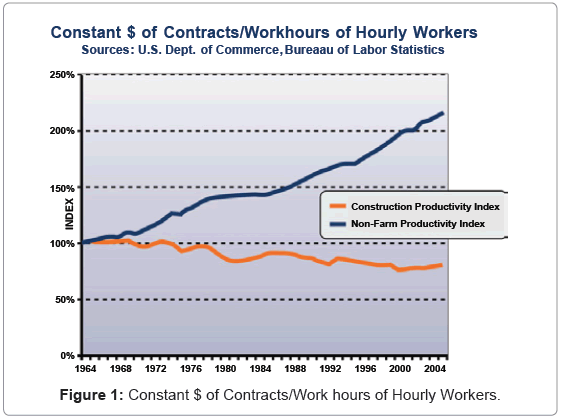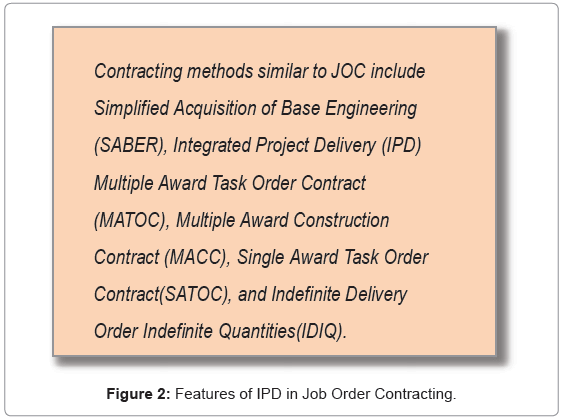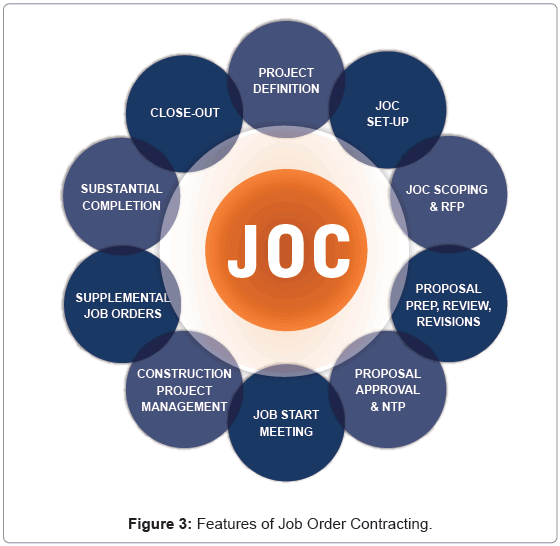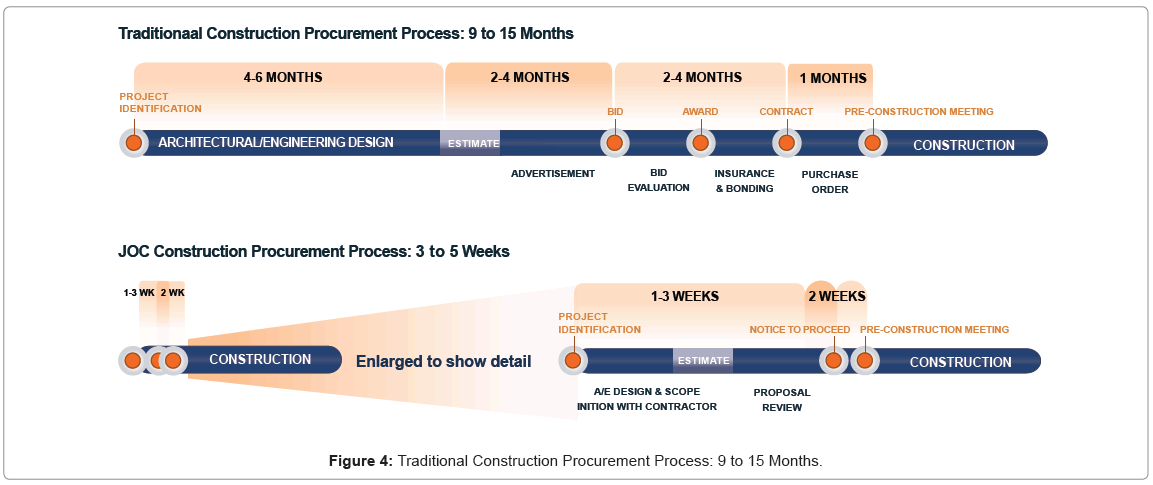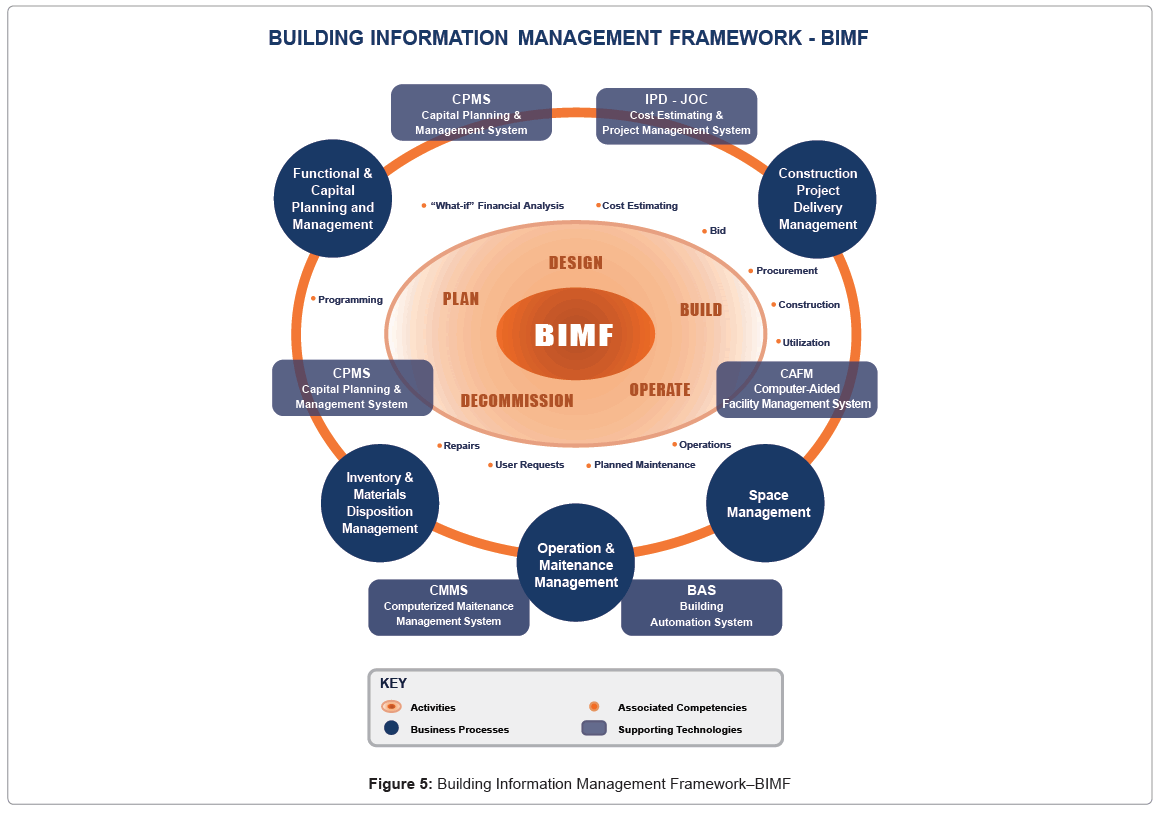Efficient Project Delivery: BIM, IPD, JOC, Cloud Computing and More
Received: 10-Oct-2012 / Accepted Date: 16-May-2013 / Published Date: 20-May-2013 DOI: 10.4172/2168-9717.1000107
Abstract
Project Delivery Methods of the Future means the only way to deliver renovation, repair, sustainability or new construction on-time and on-budget and to achieve user satisfaction is to achieve excellence at the business and project levels through collaboration as said in adaptation from Sir Michael Latham.
Keywords: Integrated project delivery (IPD); Job order contracting (JOC); Public private partnerships (PPP); Cloud computing
73886Introduction
Why has the construction industry been virtually the only major business sector that to show a decade’s long trend of productivity decline? The authors suggest that cultural, technological and supply chain barriers endemic to the AECOO (Architecture, Engineering, Construction, Owner, Operations) sector create inefficiency and waste. As a result facility managers continue to struggle with cost effective facility life-cycle management. These barriers, however, are in the process of being broken down by 1) worldwide changes in the economic and environmental landscapes, 2) The advent of disruptive technologies–specifically BIM and Cloud Computing, and 3)The associated application and integration of transparent and collaborative project delivery methods.
Why Construction Productivity has Declined for Decades
Construction productivity has been the only US industry to demonstrate productivity declines in the last three decades. While information technology implementation caused as harp uptick in productivity for most industries in the 1990’s, the construction industry continued its downward slide. More recent data shows a slight uptick in 2009 in response to ARRA funding, but this did not last. Studies suggest that construction industry productivity issues have their root in the fragmentation of design and construction, a process that was seeded in the enaissance and was fully complete by the early 19th century. Much is made of the master builder concept that dominated construction through the Renaissance. In reality there were many minds involved in the execution of the most enduring buildings that have survived the ages, but the process was integrated. When Brunelles chispen this life executing someone else’s vision forth egrand Duomo inFlorence, henotonly solved an engineering conundrum that had eluded every guild member in the city for years, he also created new machines for hoisting the heavy stones and design edscaffolding to ensure the safety of workers onsite. These practical concerns were considered as much a part of the creative challenge as the artistic design or the engineering solution (Figure 1).
But Brunelles chi may have been the last great integrator of these disciplines. The Renaissance saw the emergence of the concept of the architect as design visionary, and gradually they were removed from the actual construction process, a trend that reached its culmination in the 20th century, with increasing specialization of AECOO professions, dissimilar educational paths for design professionals vs Construction professionals and different business model. This cultural divide has resulted in unintended divergent interests which does not serve the owners interests. Efforts to shift risk and responsibility and litigation are the consequence.
In addition, procurement processes that were designed to ensure the lowest price often drive contractor inefficiencies and further remove the contractor and its expertise from the early planning and design process. Contractors spend resources in a pyramid bidding process that does not bring the construction buy a real value, rather than being engaged early when their expertise could have are alimpacton project cost and outcomes. This dispersion of the supply chain ultimately increases costs to the buyer of construction services. Conservative cultures and pocketbooks in many small AECOO firms have led to slow adoption of technology and robust, proven business processes in many of these businesses.
Drivers of Change
Fortunately, the construction industry has woken up. Beginning in the 1990’s, seminal studies of the broken construction industry started to appear and plant the seeds of change in project delivery and management approaches. Emergent technologies are now supporting an effort to improve project delivery, and that process is expedited by a number of changes in the economic and cultural landscape.
The global recession beginning in 2008, and increasing awareness of sustainability and responsible resource utilization in the face of increasing energy costs, has combined to reverse consumption trends in the US. Housing size has declined for the first time in decades, driven by economic realities but also a preference among millennial for mobility and urban lifestyle. Office spaces are becoming leaner as companies seek to reduce capital and operational expenses while accommodating an increasingly mobile workforce.
Federal mandates for increased energy efficiency are transforming many public buildings, while forward–thinking municipalities are instituting benchmarking laws to provide consumers with accurate operational cost information on buildings. Our world of data deluge extends to the built environment in the form of smart buildings, which rely on real-time monitoring to not only save costs, but increase productivity. A greater understanding of the life cycle costs of building, as well as the very real impact the built environment can have on worker productivity, are creating a paradigm shift in how we purchase and execute construction services. A fragmented, commodity approach no longer makes sense.
However, the linking of what were formerly distinct disciplines and phases of a building project requires new tools. And this transformation is happening in a time of constrained capital and operational dollars, reduced staff, and increasing demands for rapid deployment of capital funds in a fast-paced world. Emergent technologies and processes can provide a path to adapt and improve construction processes and outcomes through greater collaboration of people and integration of data.
New Technologies and Processes
Computers and software are “tools” to achieve an end. A hammer, used properly and in the right hands is very useful. In unskilled hands and used improperly the same hammer is ineffective and potentially damaging. Technology can, and will play a significant role to enable continuous improvement relative to construction cost estimating and efficient project delivery. Unfortunately, beyond the Excel spreadsheet, development of relational databases, and more recent introduction of the Internet, little new technology has been adopted to spur significant improvement in construction delivery. To achieve the next major level of advancement will require embedding and distributing robust and collaborative business processes including their use and sharing of commonly understood, transparent information.
BIM—building information modeling—and Cloud Computing are two disruptive technologies that are likely to cause a massive paradigm shift within the AECOO sector. The very foundation of the industry is beginning to change. To better appreciate the potential forth is occurrence necessitates an understand of BIM and Cloud Computing.
What is BIM?
Top Ara phrase the National Institute of Building Science’s (NIBS) somewhat longer definition of BIM, BIM is “the efficient life cycle management of the built environment supported by digital technology”. It is important to note that 3D visualization is neither the focus of BIM, nor even called out in the NIBS definition. This is not to down play the importance of data visualization, but rather to emphasize, and focus upon, the importance of facility life cycle management as the core BIM process as embedded within digital technology. Thus BIM is part process and part technology.
What is cloud computing?
Everyone has a rudimentary understanding of “the cloud,” but taking an existing, traditional software application, whether client/server or web-enabled and posting it to the Cloud via a virtual server is NOT true Cloud Computing, but “cloud-washing.” True cloud computing is centered around delivering secure, rapid and transparent “standards-based” information with the added benefit of collaboration among individuals. The level of collaboration is virtually unlimited to location, time, language, measurement, etc. For those familiar with social media tools, we might consider the Cloud as a “Facebook” for the built environment, incorporating plug-ins, wikis, micro blogs and other collaborative tools that allow the quick dissemination of information among project stake holders.
Imagine a cost estimating program that enables an unlimited number of individuals to work on the same estimate, or work exclusively on a component of a much larger project, simultaneously, in varying languages, units of measure, and currencies. At the same time the team can track, approve or disapprove changes real-time, while continuously monitoring and managing who changes what and when. Plus, you have the capability to roll forward or backward at anytime! This capability exists today, solely due to the advent of cloud computing and associated advancements in information sharing technologies beyond spreadsheets and relational databases.
The project delivery horizon
Simultaneous to technological advances (and in some cases preceding them) are the development of integrated project delivery methods that can fully leverage the collaborative possibilities of BIM and the Cloud. Job Order Contracting, Integrated Project Delivery, Public Private Partnerships and Energy Performance Contracts are all filling the need of building owners to construct more efficiently and collaboratively. These cutting-edge delivery methods have the following key characteristics in common:
1) Qualifications Based or Best Value Selection
2) Some form of pricing transparency
3) Early collaboration between projects take holders
4) Some form of financial incentive to drive performance
5) Appropriate distribution of risk
Integrated project delivery: Integrated Project Delivery (IPD) sits at the bleeding edge of construction delivery. In its purest form IPD relies on an alliance contract that binds the project participants in a “sinker swim together” agreement with shared risk and reward, thus incentivizing cooperation and collaboration. Not only are contractors and owners full stakeholders in the design process; sub contractors, suppliers and fabricators are also integral to the collaborative process and can be a part to the agreement. Facility Managers will typically play an active role in the IPD process, informing design decisions that will impact ongoing operations.
Design and Construction professionals are selected based on pure Qualifications Based Selection. The typical pricing structure is a target cost, with100% reimbursement for direct costs, profit at risk, and shared incentive award of savings below the target cost. This contract structure is thus very relianton transparent pricing as well as the free exchange of project information. IPD projects typically leverage BIM and some form of Cloud computing to facilitate the free exchange of ideas and project data. Some of the most successful handovers of BIM data to facility management have been on IPD projects.
Job order contracting: Job Order Contracting (JOC) shares many of the features of IPD, but is focused on small-to medium sized renovation and remodel projects that make up the majority of a facility manager’s project portfolio. In many ways JOC is a delivery method ahead of its time, having been introduced in the US Army in the late 1980’s. It is a competitively procured, fixed unit price, indefinite quantity construction procurement and by integrating the design and construction of smaller projects, JOC can compress project timelines to better respond to the day-to-day needs for flexibility within a large facility (Figure 2). The design process is streamlined and involves design professionals at the level appropriate given the project scope; sometimes owner and contractor produce a solid statement of work and simplified design which is the most efficient approach. Pricing transparency is provided in the form of a unit price book (UPB)—a construction cost database of detailed priced tasks, including construction, maintenance, repair, and renovation work items and specifications. These tasks form the pricing basis for collaboratively–scoped projects, thus providing price certainty and meeting most procurement regulations. Since JOCs require a highly–performing contractor to provide these additional services, it is most typically procured through a Best Value or Qualifications Based process. Risk is fairly distributed, with the contractor taking on the performance risk of procuring sub contracts and materials within the pre-agreed unit prices, and the owner allowing for annual updates to the price book to reflect construction inflation (Figure 3).
Because JOC is a long-term (3-5 years) unit price contract with a low work guarantee but clear volume potential (ranging from $1m per year to the tens of millions), it provides a contractual incentive in the form of additional work. The facility owner is not compelled to utilize the contract but will want to do so if the contractor is providing a high level of service. Another advantage of the long–term contract is that once base line relationships and working processes are established in the first year, the project team can begin to implement reiterative, incremental process improvements that increase efficiency for the entire team, thus increasing profitability for contractors while simultaneously reducing costs for owners. Facilities staff and contractors will typically develop a strong collaborative working relationship that benefits project outcomes, as well (Figure 4).
Public Private Partnerships (PPP) and design-build-own-operate: The move towards integration perhaps finds it fullest form in Public Private Partnerships, which combine not only design and construction but also financing and ongoing operations for public projects. This turnkey type of development and operation has long been used in the private sector, but in the last five years many public owners struggling with capital funding have turned to PPPs to execute projects, and enabling legislation has been introduced in many states. The appeal is not limited to up-front financing. With PPPs, owners can procure single-source responsibility, even including ongoing operations of a facility, thus integrating design, construction and operations and ensuring that efficient operations are driving the most appropriate design and construction decisions.
Energy performance contracts: As owners look to upgrade existing building stock for energy efficiency with limited capital dollars and a need for certainty in cost savings, energy performance contracts are poised to expand. These contracts are not new; they have been around since the late 80’s. But increasing awareness and mandates to reduce energy use in existing buildings, and horizon financing solutions, will drive increased reliance on this turnkey solution. Energy service companies arrange for third–party financing of energy upgrades based on the anticipated savings, and the contractor is paid from those savings.
The benefits of progressive delivery methods have been well established. As then west delivery method, IP Dresultsatth is point is primarily anecdotal. Job Order Contracting has been the subject of several studies citing ease of use and increased quality, upto 90% project timeline savings on small projects, and 8 to 15% cost savings through efficiency gains. PPPs have brought critical infrastructure mega projects online as much as ten years earlier than would have been otherwise possible.
Crystal ball: what does the future hold? Performance-based contract provisions that reward the positive results of collaborative project delivery will likely evolve. As technology allows us to better understand and track the connection between building design, building performance, and worker performance and productivity, even more progressive contract incentives may become common place. By looking holistically at the costs and benefits of energy use, indoor air quality, day lighting, renovation disruption to occupants, and even aesthetics, incentive packages for the project team could be based on the ultimate goals of increased productivity, employee engagement, and well-being for building occupants.
BIM will be increasingly important to not only capital projects but relatively minor upgrades as well. As a baseline of building information is developed, all projects will be expected to populate a model and feed updates to facility management. Eventually these real-time models will be stitched together to create “maps” of our built environment and infrastructure across entire cities.
New roles: Emerging project delivery methods demand more sophisticated owners who can take the irrightful place as equals take holders in the design and construction process. Transparency of pricing and design information is only useful to an owner that understands it. Owners will become ever more sophisticated in their ability to track the performance of their building team members and project costs in real-time, using the cloud to better control projects. Owners will need to be able to determine when the target cost in an IPD should be adjusted; Owners using JOC may need to develop the ability to create their own internal unit price estimates, utilizing cloud-based software to automatically compare it to contract or estimates in seconds. Technology in the form of cloud computing will give owners a window in to their projects like never before.
A common language: The emerging level of collaboration and transparency requires a common “language”. Much work has been done in this area, and is continuing at an accelerated pace. Notable examples include robust data architectures such as MASTERFORMAT and UNIFORMAT, as well as newer examples including OMNICLASS and COBIE.
Associated standardized processes representing core “knowledge domains” are also important, each with their own interrelated dictionary of terms, benchmarks, and metrics. Examples of such terms and process can be found in almost every area. The diagram below represents a conceptual framework of several knowledge domains, each important to BIM (Figure 5).
Summary
Much of the traditional AECOO sector remains inefficient, unproductive, antagonistic, and wasteful. However, we are on the verge of dramatic change resulting from the influences of the disruptive technologies of BIM and Cloud Computing, as well as the altering global environmental and economic landscape. How soon a true paradigm shift will occur is in question, especially for an industry where a high percentage of Owners, AEs, and Contractors still rely on paper vs. electronic documents. Collaboration, team integration and partnering are only at nascent stage, The Construction and Facility Management sectors are faced with an unprecedented newest of economic, environmental, and technological issues requiring a higher level of collaboration among all constituencies–owners, architects, engineers, contractors, oversight groups/regulatory bodies, and the general community. The Ability to more efficiently conceptualize, create, cost, prioritize, start, and report on construction projects is needed to attain relater economic competitiveness and to address global climate change. Organizations electing to remain with the status quo with respect to traditional construction planning and project delivery methods risk falling short on these goals and being left behind.
Citation: Cooley L, Cholakis P (2013) Efficient Project Delivery: BIM, IPD, JOC, Cloud Computing and More. J Archit Eng Tech 2: 107. DOI: 10.4172/2168-9717.1000107
Copyright: ©2013 Cooley L, et al. This is an open-access article distributed under the terms of the Creative Commons Attribution License, which permits unrestricted use, distribution, and reproduction in any medium, provided the original author and source are credited.
Select your language of interest to view the total content in your interested language
Share This Article
Recommended Journals
Open Access Journals
Article Tools
Article Usage
- Total views: 16822
- [From(publication date): 7-2013 - Aug 31, 2025]
- Breakdown by view type
- HTML page views: 12076
- PDF downloads: 4746

